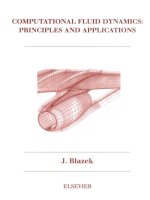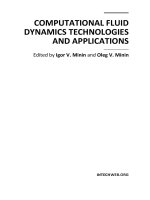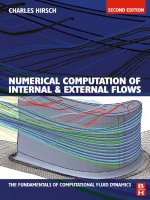Fluid dynamics và ứng dụng tính toán
Bạn đang xem bản rút gọn của tài liệu. Xem và tải ngay bản đầy đủ của tài liệu tại đây (2.8 MB, 44 trang )
Introduction to Fluid Mechanics*
Fred Stern, Tao Xing, Jun Shao, Surajeet Ghosh
8/26/2005
AFD
EFD
CFD
U 0
DU
1 2
p
U ui u j
Dt
Re
57:020 Fluid Mechanics
1
Fluid Mechanics
• Fluids essential to life
• Human body 65% water
• Earth’s surface is 2/3 water
• Atmosphere extends 17km above the earth’s surface
• History shaped by fluid mechanics
• Geomorphology
• Human migration and civilization
• Modern scientific and mathematical theories and methods
• Warfare
• Affects every part of our lives
57:020 Fluid Mechanics
2
History
Faces of Fluid Mechanics
Archimedes
(C. 287-212 BC)
Navier
(1785-1836)
Newton
(1642-1727)
Stokes
(1819-1903)
Leibniz
(1646-1716)
Reynolds
(1842-1912)
57:020 Fluid Mechanics
Bernoulli
Euler
(1667-1748)
(1707-1783)
Prandtl
Taylor
(1875-1953)
(1886-1975)
3
Significance
• Fluids omnipresent
• Weather & climate
• Vehicles: automobiles, trains, ships, and
planes, etc.
• Environment
• Physiology and medicine
• Sports & recreation
• Many other examples!
57:020 Fluid Mechanics
4
Weather & Climate
Tornadoes
Thunderstorm
Global Climate
Hurricanes
57:020 Fluid Mechanics
5
Vehicles
Surface ships
Aircraft
High-speed rail
57:020 Fluid Mechanics
Submarines
6
Environment
Air pollution
57:020 Fluid Mechanics
River hydraulics
7
Physiology and Medicine
Blood pump
Ventricular assist device
57:020 Fluid Mechanics
8
Sports & Recreation
Water sports
Cycling
Auto racing
Offshore racing
Surfing
57:020 Fluid Mechanics
9
Fluids Engineering
Reality
Fluids Engineering System
EFD, U
D
B2 P2
Components
Idealized
Mathematical Physics Problem Formulation
AFD, U m
57:020 Fluid Mechanics
CFD,
2
2
U s U SM
U SN
10
Analytical Fluid Dynamics
The theory of mathematical physics
problem formulation
• Control volume & differential analysis
• Exact solutions only exist for simple
geometry and conditions
• Approximate solutions for practical
applications
•
• Linear
• Empirical relations using EFD data
57:020 Fluid Mechanics
11
Analytical Fluid Dynamics
•
Lecture Part of Fluid Class
•
•
•
•
•
•
•
•
Definition and fluids properties
Fluid statics
Fluids in motion
Continuity, momentum, and energy principles
Dimensional analysis and similitude
Surface resistance
Flow in conduits
Drag and lift
57:020 Fluid Mechanics
12
Analytical Fluid Dynamics
• Example: laminar pipe flow
UD
2000
Assumptions: Fully developed, Low Re
Approach: Simplify momentum equation,
Schematic
integrate, apply boundary conditions to
determine integration constants and use
energy equation to calculate head loss
0
2
0
0
u 2u
Du
p
2 2 gx
Dt
x
y
x
Exact solution :
u(r) 1 ( p)(R2 r 2)
4 x
8 du
8 w dy w 64
f
Friction factor:
V 2 V 2 Re
p1
p2
L V 2 32 LV
hf f
Head loss: z1 z2 h f
D 2g
D2
57:020 Fluid Mechanics
13
Analytical Fluid Dynamics
• Example: turbulent flow in smooth pipe( Re 3000)
Three layer concept (using dimensional analysis)
u u u
1.
y yu
u* w
0 y 5
Overlap layer (viscous and turbulent shear important)
1
u ln y B
3.
*
Laminar sub-layer (viscous shear dominates)
u y
2.
*
20 y 105
(=0.41, B=5.5)
Outer layer (turbulent shear dominates)
Assume log-law is valid across entire pipe:
Uu
r
5
f
1
y 10
*
u
r0
u r
u*
*
1 r0 r u
ln
B
Integration for average velocity and using EFD data to adjust constants:
1
2log Re f 1 2 .8
f
57:020 Fluid Mechanics
14
Analytical Fluid Dynamics
• Example: turbulent flow in rough pipe
Both laminar sublayer and overlap
layer
Inner
layer:by uroughness
are
affected
u y k
Outer layer: unaffected
Overlap layer:
1 y
u ln constant
k
Three regimes of flow depending on k+
1. K+<5, hydraulically smooth (no effect of roughness)
2. 5 < K+< 70, transitional roughness (Re dependent)
3. K+> 70, fully rough (independent Re)
For 3, using EFD data to adjust constants:
1 y
u ln 8.5 f Re
k
Friction factor:
57:020 Fluid Mechanics
1
k D
2log
3.7
f
15
Analytical Fluid Dynamics
• Example: Moody diagram for turbulent pipe flow
Composite Log-Law for smooth and rough pipes is given by the Moody diagram:
1
f
1
2
k D
2.51
2log
12
3.7 Re f
57:020 Fluid Mechanics
16
Experimental Fluid Dynamics (EFD)
Definition:
Use of experimental methodology and procedures for solving fluids engineering
systems, including full and model scales, large and table top facilities,
measurement systems (instrumentation, data acquisition and data reduction),
uncertainty analysis, and dimensional analysis and similarity.
EFD philosophy:
• Decisions on conducting experiments are governed by the ability of the expected
test outcome, to achieve the test objectives within allowable uncertainties.
• Integration of UA into all test phases should be a key part of entire experimental
program
• test design
• determination of error sources
• estimation of uncertainty
• documentation of the results
57:020 Fluid Mechanics
17
Purpose
• Science & Technology: understand and investigate a
phenomenon/process, substantiate and validate a theory
(hypothesis)
• Research & Development: document a process/system,
provide benchmark data (standard procedures,
validations), calibrate instruments, equipment, and
facilities
• Industry: design optimization and analysis, provide data
for direct use, product liability, and acceptance
• Teaching: instruction/demonstration
57:020 Fluid Mechanics
18
Applications of EFD
Application in science & technology
Application in research & development
Picture of Karman vortex shedding
Tropic Wind Tunnel has the ability to create
temperatures ranging from 0 to 165 degrees
Fahrenheit and simulate rain
57:020 Fluid Mechanics
19
Applications of EFD (cont’d)
Example of industrial application
NASA's cryogenic wind tunnel simulates flight
conditions for scale models--a critical tool in
designing airplanes.
Application in teaching
Fluid dynamics laboratory
57:020 Fluid Mechanics
20









